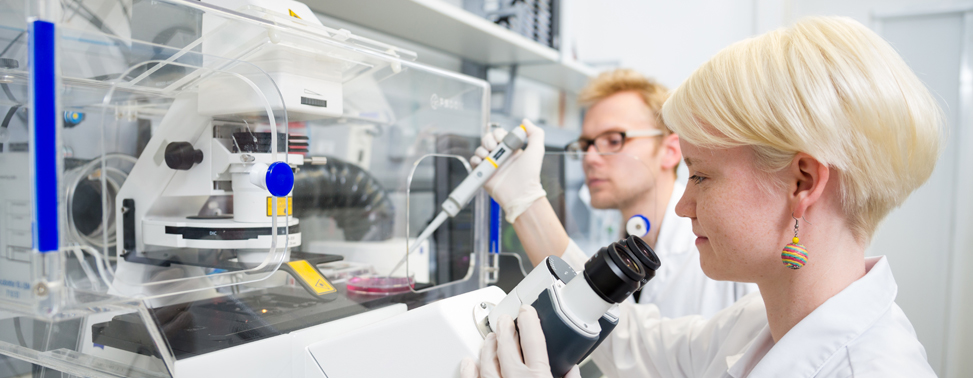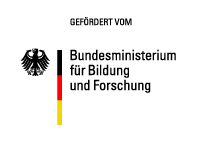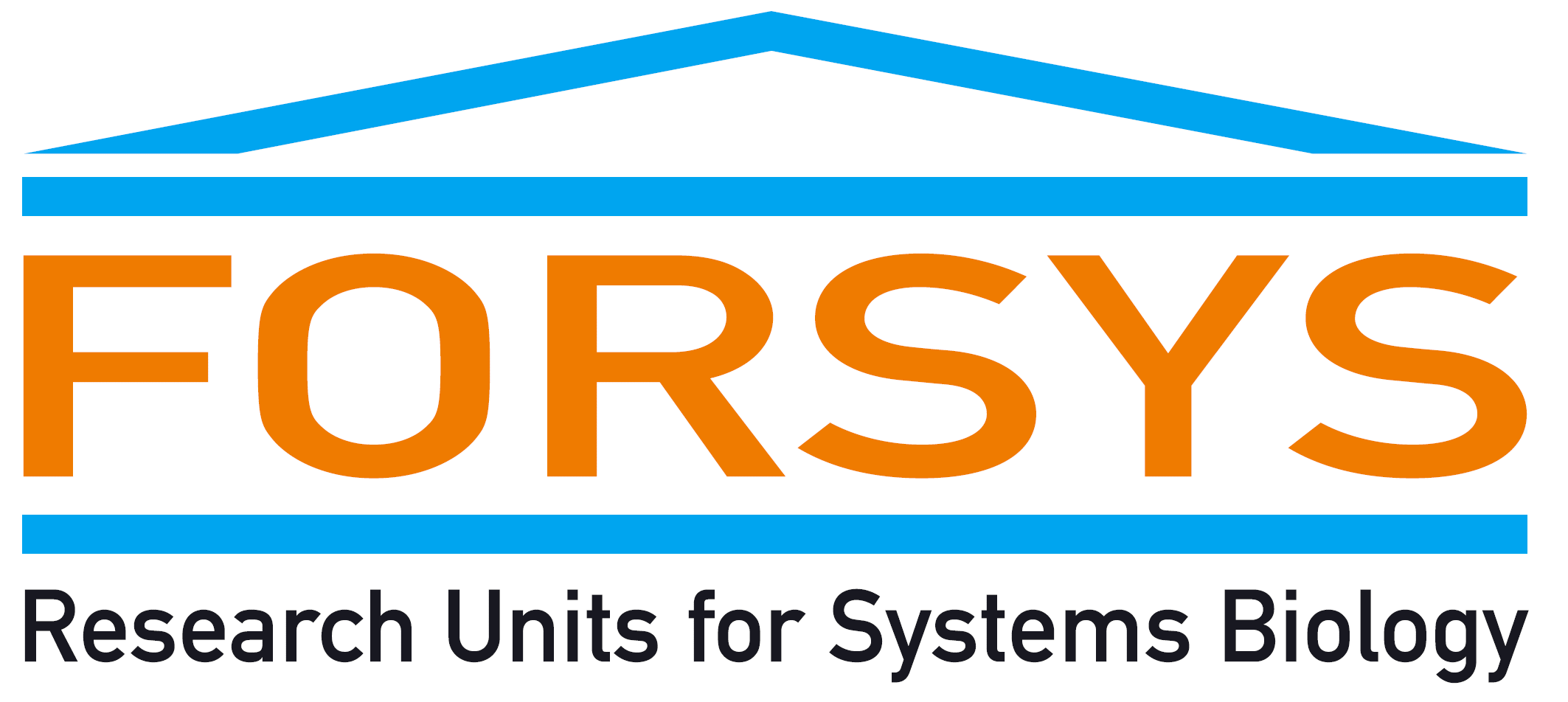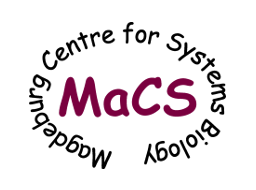Anna Dittrich

Dr. rer. nat. Anna Dittrich
Systembiologie
2024
Begutachteter Zeitschriftenartikel
Dysregulated Gab1 signalling in triple negative breast cancer
Bongartz, Hannes; Mehlwald, Nora; Seiß, Elena A.; Schumertl, Tim; Nass, Norbert; Dittrich, Anna
In: Cell communication and signaling - London : Biomed Central, Bd. 22 (2024), Artikel 161, insges. 19 S.
2023
Begutachteter Zeitschriftenartikel
Non-canonical STAT3 function reduces REDD1 transcription
Köhler, Nadine; Wundrack, Nicole; Schulz, Svenja; Bartonitz, Florian; Schaper, Fred; Dittrich, Anna
In: The FEBS journal / Vereinigung der Europäischen Biochemischen Gesellschaften - Oxford [u.a.] : Wiley-Blackwell, Bd. 290 (2023), Heft 7, S. 1765-1781
Begutachteter Zeitschriftenartikel
Quantification of total and phosphorylated STAT3 by calibrated western blotting
Köhler, Nadine; Miri, Niloufarsadat; Dittrich, Anna
In: STAR Protocols - Cambridge, MA : Cell Press, Bd. 4 (2023), Heft 3, Artikel 102508, insges. 19 S.
Begutachteter Zeitschriftenartikel
Quantification of membrane-bound cytokine receptors by calibrated flow cytometry
Miri, Niloufarsadat; Köhler, Nadine; Dittrich, Anna
In: STAR Protocols - Cambridge, MA : Cell Press, Bd. 4 (2023), Heft 3, Artikel 102511, insges. 14 S.
2022
Begutachteter Zeitschriftenartikel
Decoding cellular communication - an information theoretic perspective on cytokine and endocrine signaling
Schaper, Fred; Jetka, Tomasz; Dittrich, Anna
In: Current opinion in endocrine and metabolic research - Amsterdam : Elsevier . - 2022
2021
Begutachteter Zeitschriftenartikel
The tyrosine phosphatase SHP2 increases robustness and information transfer within IL-6-induced JAK/STAT signalling
Fiebelkow, Jessica; Guendel, André; Guendel, Beate; Mehwald, Nora; Jetka, Tomasz; Komorowski, Michal; Waldherr, Steffen; Schaper, Fred; Dittrich, Anna
In: Cell communication and signaling - London: Biomed Central, Bd. 19 (2021), 1, insges. 19 S.
2020
Begutachteter Zeitschriftenartikel
Hepatocyte KLF6 expression affects FXR signalling and the clinical course of primary sclerosing cholangitis
Sydor, Svenja; Manka, Paul Peter; Buren, Lea; Theurer, Sarah; Schwertheim, Suzan; Best, Jan; Heegsma, Janette; Saeed, Ali; Vetter, Diana; Schlattjan, Martin; Dittrich, Anna; Fiel, Maria Isabel; Baba, Hideo Andreas; Dechêne, Alexander; Cubero, Francisco Javier; Gerken, Guido; Canbay, Ali E.; Moshage, Han; Friedman, Scott L.; Faber, Klaas Nico; Bechmann, Lars Peter
In: Liver international - Oxford : Wiley-Blackwell, Bd. 40 (2020), Heft 9, S. 2172-2181
2019
Begutachteter Zeitschriftenartikel
Response to IL-6 trans- and IL-6 classic signalling is determined by the ratio of the IL-6 receptor α to gp130 expression - fusing experimental insights and dynamic modelling
Reeh, Heike; Rudolph, Nadine; Billing, Ulrike; Christen, Henrike; Streif, Stefan; Bullinger, Eric; Schliemann-Bullinger, Monica; Findeisen, Rolf; Schaper, Fred; Huber, Heinrich; Dittrich, Anna
In: Cell communication and signaling - London: Biomed Central, Vol. 17.2019, 1, Art. 17:46, insgesamt 21 Seiten
Begutachteter Zeitschriftenartikel
Intragenic regulation of SOCS3 isoforms
Klepsch, Oliver; Namer, Lise Sarah; Köhler, Nadine; Kaempfer, Raymond; Dittrich, Anna; Schaper, Fred
In: Cell communication and signaling - London: Biomed Central, Volume 17 (2019), 1, Artikel 70, insgesamt 15 Seiten
Begutachteter Zeitschriftenartikel
Robustness and information transfer within IL-6-induced JAK/STAT signalling
Billing, Ulrike; Jetka, Tomasz; Nortmann, Lukas; Wundrack, Nicole; Komorowski, Michal; Waldherr, Steffen; Schaper, Fred; Dittrich, Anna
In: Communications biology - London: Springer Nature, Vol. 2.2019, Art. 27, insgesamt 14 S.
2018
Begutachteter Zeitschriftenartikel
Quantitative proteomics and systems analysis of cultured H9C2 cardiomyoblasts during differentiation over time supports a function follows form model of differentiation
Kankeu, Cynthia; Clarke, Kylie; Van Haver, Delphi; Gevaert, Kris; Impens, Francis; Dittrich, Anna; Roderick, H. Llewelyn; Passante, Egle; Huber, Heinrich
In: Molecular omics: research in proteomics, transcriptomics, metabolomics and other omics sciences - Cambridge: Royal Society of Chemistry, 2018[Online first]
2016
Begutachteter Zeitschriftenartikel
Interleukin-6 influences stress-signalling by reducing the expression of the mTOR-Inhibitor REDD1 in a STAT3-dependent manner
Pinno, Jessica; Bongartz, Hannes; Klepsch, Oliver; Wundrack, Nicole; Poli, Valeria; Schaper, Fred; Dittrich, Anna
In: Cellular signalling - Amsterdam [u.a.]: Elsevier Science, 1989, Bd. 28.2016, 8, S. 907-916
2015
Begutachteter Zeitschriftenartikel
A two-level approach for fusing early signaling events and long term cellular responses
Rudolph, Nadine; Meyer, Tina; Franzen, Kristina; Garbers, Christoph; Schaper, Fred; Streif, Stefan; Dittrich, Anna; Findeisen, Rolf
In: IFAC-PapersOnLine/ Internationale Förderung für Automatische Lenkung - Frankfurt: Elsevier, 2015, Bd. 48.2015, 8, S. 1228-1233[Kongress: 9th IFAC Symposium on Advanced Control of Chemical Processes ADCHEM 2015, Whistler, Canada, 7-10 June, 2015]
Begutachteter Zeitschriftenartikel
Systems biology of IL-6, IL-12 family cytokines
Dittrich, Anna; Hessenkemper, Wiebke; Schaper, Fred
In: Cytokine & growth factor reviews - Amsterdam [u.a.]: Elsevier Science, Bd. 26.2015, 5, S. 595-602
2013
Buchbeitrag
Determination of protein turnover rates in the JAK/STAT pathway using a radioactive pulse-chase approach
Dittrich, Anna; Siewert, Elmar; Schaper, Fred
In: JAK-STAT signalling: methods and protocols / ed. by Sandra E. Nicholson and Nicos A. Nicola: methods and protocols - New York [u.a.]: Humana Pr., 2013 . - 2013, S. 69-80 - (Methods in molecular biology; 967)
Begutachteter Zeitschriftenartikel
JAK/STAT signalling - an executable model assembled from molecule-centred modules demonstrating a module-oriented database concept for systems and synthetic biology
Blätke, Mary Ann; Dittrich, Anna; Rohr, Christian; Heiner, Monika; Schaper, Fred; Marwan, Wolfgang
In: Molecular BioSystems - Cambridge: Royal Society of Chemistry, 2005, Bd. 9.2013, S. 1290-1307
2012
Buchbeitrag
JAK-STAT signalling as example for a database-supported modular modelling concept
Blätke, Mary Ann; Dittrich, Anna; Heiner, Monika; Schaper, Fred; Marwan, Wolfgang
In: Computational Methods in Systems Biology / Gilbert , David - Berlin, Heidelberg : Springer ; Gilbert, David . - 2012, S. 362-365 - (Lecture Notes in Bioinformatics; 7605) Kongress: CMSB 2012 10 London, UK 2012.10.03-05
Originalartikel in begutachteter internationaler Zeitschrift
Glucocorticoids increase interleukin-6 dependent gene induction by interfering with the expression of the SOCS 3 feedback inhibitor
Dittrich, Anna; Khouri, Christina; Sackett, Sara Dutton; Ehlting, Christian; Böhmer, Oliver; Albrecht, Ute; Bode, Johannes G.; Trautwein, Christian; Schaper, Fred
In: Hepatology. - Hoboken, NJ : Wiley Interscience, Bd. 55.2012, 1, S. 256-266
Originalartikel in begutachteter internationaler Zeitschrift
Model-driven experimental analysis of the function of SHP-2 in IL-6-induced Jak/STAT signaling
Dittrich, Anna; Quaiser, Tom; Khouri, Christina; Görtz, Dieter; Mönnigmann, Martin; Schaper, Fred
In: Molecular BioSystems. - Cambridge : Royal Society of Chemistry, 8, S. 2119-2134, 2012
Originalartikel in begutachteter internationaler Zeitschrift
Interleukin-6 signalling - more than Jaks and STATs
Eulenfeld, René; Dittrich, Anna; Khouri, Christina; Müller, Pia J.; Mütze, Barbara; Wolf, Alexandra; Schaper, Fred
In: European journal of cell biology. - Amsterdam : Elsevier, Bd. 91.2012, 6/7, S. 486-495
2011
Originalartikel in begutachteter internationaler Zeitschrift
Glucagon counteracts interleukin-6-dependent gene expression by redundant action of EPAC and PKA
Khouri, Christina; Dittrich, Anna; Sackett, Sara Dutton; Denecke, Bernd; Trautwein, Christian; Schaper, Fred
In: Biological chemistry - Berlin [u.a.]: de Gruyter, Bd. 392.2011, S. 1123-1134
Originalartikel in begutachteter internationaler Zeitschrift
A simple work flow for biologically inspired model reduction - application to early JAK-STAT signaling
Quaiser, Tom; Dittrich, Anna; Schaper, Fred; Mönnigmann, Martin
In: BMC systems biology - London: BioMed Central, Bd. 5.2011, 30, insges. 30 S.
09/2004 | Vordiplom in Biologie Heinrich-Heine Universität Düsseldorf |
09/2007 | Diplom in Biologie RWTH Aachen |
10/2007-09/2009 | Zusatzstudium Wirtschaftswissenschaften RWTH Aachen |
10/2007-05/2010 | Institut für Biochemie & Molekularbiologie |
seit 06/2010 | Institut für Biologie, Lehrstuhl für Systembiologie |
03/2012 | Dissertation an der OvGU Magdeburg |
01/2014-04/2014 | Gastwissenschaftlerin, Keio University Tokyo |
- Prof. Dr. Stefan Rose-John, Christian-Albrechts-Universität Kie
- Prof. Dr. Jürgen Scheller, Heinrich-Heine-Universität Düsseldorf
- Prof. Dr. Rolf Findeisen, Otto-von-Guericke Universität Magdeburg
- Prof. Akihiko Yoshimura, Keio University School of Medicine
- Conaris Research Institute AG, Kiel
- Prof. Dr. Raymond Kaempfer, Hebrew University, Jerusalem, Israel
Interleukin-6
JAK/STAT
SHP2
SOCS3
Systembiologie
Intrazelluläre FACS Analysen
Aktuelle Projekte
Intravascular crosstalk of interleukin-6 and therapeutic glucocorticoids in SARS-CoV2 infection
Laufzeit: 01.01.2022 bis 31.12.2024
SARS-CoV2 is highly infectious and causes the disease COVID-19. 10-20 % of patients infected with SARS-CoV2 develop severe symptoms. In these patients, SARS-CoV2 can trigger a cytokine storm that leads to the life-threatening Cytokine Release Syndrome (CRS). Among the cytokines released, Interleukin-6 (IL-6), a paradigm pro-inflammatory cytokine with deleterious functions, correlates strongly with and predicts the severity of COVID-19. Noteworthy, systemic vascular complications in critically ill COVID-19 patients represent a main risk. The expression of SARS-CoV2 entry factors on vascular cells in virtually all organs suggests that vascular damage could be a consequence of lytic viral infection of vascular cells. However, it is also discussed that impaired vessel function is mediated by loss of function of non-infected vascular cells exposed to systemically elevated levels of IL-6. In addition, SARS-CoV2 may locally affect IL-6 signalling pathways by controlling the expression and release of IL-6 receptor subunits and IL-6 itself. The suspected role of IL-6 in the development of COVID-19 is the basis for several ongoing clinical trials with approved drugs that either inhibit IL-6 function extracellularly or intervene in intracellular IL-6 signal processing. However, the molecular mechanisms and pathophysiological consequences of IL-6 and the causes of vascular damage in COVID-19 are still unknown.
Preliminary results from clinics show that immunosuppressive glucocorticoids (GC) reduce deaths in certain patient groups by for so far unknown reasons. Remarkedly, both extracellular and intracellular IL-6 signalling is influenced by GC and vice versa IL-6 influences GC signalling. To address the increasing concerns about the efficacy of GC treatment for COVID-19 and possible (adverse) effects of GCs on the vascular system, the molecular mechanisms of GC action in SARS-CoV2-infected cells and the crosstalk of GC and IL-6 must be elucidated.
The aim of this project is to gain profound translational knowledge about molecular mechanisms and pathophysiological consequences of IL-6 and GC action in SARS-CoV2-infected cells and non-infected vascular cells. For this purpose, we will use highly defined 2D and 3D in vitro vascular models and single cell techniques to define the consequences of SARS-CoV2 infection in the two integral vessel cell types, endothelial cells and smooth muscle cells. The results obtained will be a prerequisite for understanding SARS-CoV2 infection and targeted development of treatments to cope with COVID-19.
Decrypting the pleiotropic role of the immune checkpoint molecule, ICOS-Ligand, in immunoconversion of pro-inflammatory to pro-senescence endothelial cell phenotype in cardiovascular diseases
Laufzeit: 16.01.2023 bis 30.08.2024
1. State-of the Art and Key Research Question(s): Coronary Artery Disease (CAD) pathophysiology is initiated when coronary arteries supplying blood to the heart are being blocked with the accumulating plaques, forming varying degree of fatty streaks, built from inflammatory cells, including monocytes derived macrophages and lymphocytes [3-5]. These blood patrolling immune cells attain an inflammatory state in response to the signals delivered by a dysfunctional endothelium, which is initially caused by deposition and subsequent physicochemical modification of circulating low-density lipoproteins (LDL) in subendothelial spaces. Further, the oxidized lipid ladened pathological macrophages residing at subendothelial spaces produce excessive reactive oxygen species (ROS) and proinflammatory cytokines, including IL-6, which decreases nitric oxide bioavailability and substantially increases oxidative stress in the plaque microenvironment. Under these circumstances, the damaged endothelium releases VWF, which is not only best known for its role in hemostasis and thrombosis, supporting platelet adhesion and aggregation, but also plays a central role in vascular inflammation, favoring leukocyte recruitment and extravasation. Such a constant stimulus, including oxidative stress, initiates endothelial senescence, the process characterized by cell cycle arrest and changes in pro-inflammatory gene expression, in the vasculature. With regard to vascular inflammation in CAD patients, we consider a shift from pro-inflammatory to the pro - senescence state of a vascular endothelium as a key decision point that must be focused and targeted to mitigate the conversion of senescence. This is highly essential because senescence associated with vascular endothelium secretes senescence associated secretory phenotypes (SASP), in addition to many dramatic changes occurring at the intracellular level. Further, endothelial-SASP aggravates and sustain chronic inflammation throughout the lifetime of a CAD patient, which lowers the quality of autologous vessel when used for coronary artery bypass graft (CABG) surgery, as CABG still is considered as a gold standard method for multivessel coronary artery disease. These autologous bypass grafts (vessels) are highly prone to getting occluded with thrombus and therefore exhibit a poor long-term potency, which evidently raises the question on the quality of autologous vessel. Of note, vascular endothelial senescence was evident in arterial diseases. Apart, it has been reported that the ligand for inducible costimulator (ICOS-L) were increasingly expressed on an activated endothelium, under the influence of proinflammatory cytokines. The ICOS-L is one of the immune checkpoint molecule that binds to ICOS, expressed on activated T cells, where the ICOS-L/ICOS axis exhibits multifaceted role in immune function, including polarization towards (i) TH1 immunity; (ii) TH2 immunity; (iii) TH17 immunity; (iv) Tregs immunity; (v) germinal center formation and B cell immunity in antibody production. However, the potential role of ICOS-L in inducing or preventing endothelial senescence is not yet explored and is therefore largely unknown.
1.2 Unresolved key questions: Since cardiovascular inflammation diseases remains to be the first leading cause of death globally, we intend to stamp on critical window phase where the transformation of vascular endothelium occurs from pro-inflammatory to pro-senescence state, with the aim of preserving the quality of vessels, thereby avoiding further worsening from chronic inflammation due to senescence and thereby to subsequently increase the patency rate when used for CABG surgery. For this purpose, we explore an in-depth role of ICOS-L/ICOS axis in this above-mentioned decision phase in the presence of atherosclerotic progressive factors.
A. The atherosclerosis related soluble factors, including vWF, blood clotting factors and immune cell associated cytokines, IL-6, IL-1ß, IL-8 increase the endothelial transmembrane expression level of ICOS-L will be explored
B. Despite increased ICOS-L expression, the knowledge of its functional significance on vascular endothelium is largely unknown and will therefore be addressed during the state of (i) initial inflammation, (ii) progressive inflammation and (iii) transformation of inflammation to senescence. This will be achieved by determining the recruitment of intracellular anti-senescence molecules, including SIRTUIN-1 and FOXO1, where these pathways will be thoroughly investigated. Here, we intend to employ the ApoE-/-atherosclerotic mouse model, ICOS-L transgenic and knockout mouse to investigate the senomorphic role of ICOS-L in vivo as well as in vitro, with endothelial cell culture systems, with ICOS-L overexpression and ICOS-L knockout using CRIPSR-Cas9 tools.
Abgeschlossene Projekte
Crosstalk zwischen IL-6 und Glucocorticoiden
Laufzeit: 01.01.2013 bis 01.01.2018
Glukokortikoide (z.B. Cortisol) sind körpereigene Botenstoffe, die in Stresssituationen ausgeschüttet werden. Synthetische Glukokortikoide (z.B. Dexamethason) werden seit den 1950er Jahren zur Behandlung entzündlicher Krankheiten eingesetzt. Die genauen Mechanismen ihrer Wirkungen und Nebenwirkungen sind jedoch bis heute nicht verstanden. Es ist bekannt, dass Glukokortikoide die IL-6-induzierte Expression von Akut-Phase Proteinen erhöhen. Zusammen mit der Arbeitsgruppe von Prof. Dr. Bode (Düsseldorf) konnten wir zeigen, dass dies unter anderem durch eine verstärkte JAK/STAT Signaltransduktion ausgelöst wird. Die Hyperaktivierung der JAK/STAT Signaltransduktion konnten wir durch eine reduzierte Expression des IL-6-induzierten feed-back Inhibitors SOCS3 erklären. Wir untersuchen die molekularen Ursachen dieses Prozesses, um zu zeigen, auf welcher Ebene der Proteinexpression die SOCS3 Synthese unterdrückt wird. Darüber hinaus studieren wir auch die molekularen Grundlagen des Wechselspiels zwischen glandulären Hormonen (Prostaglandin, Glucagon), sowie pro-inflammatorischen Zytokinen (z.B. Interleukin 1) und IL-6.
InTraSig:Entwicklung einer personalisierten Anti-Entzündungstherapie zur Inhibition des Interleukin-6-Trans-Signalwegs
Laufzeit: 01.09.2014 bis 31.08.2017
Das interdisziplinäre Projekt hat zum Ziel, einen systemischen Blick auf die komplexe Biologie des Zytokins Interleukin-6 (IL-6) zu entwickeln, welches als eines der wichtigsten Entzündungsmediatoren angesehen wird. IL-6 ist derzeit das Zielmolekül mehrerer therapeutischer Strategien zur Behandlung von Autoimmunerkrankungen. Zwei verschiedene Mechanismen der IL-6-Signaltransduktionsinitiation sind bekannt: das klassische Signalling" über membrangebundene IL-6-Rezeptoren (IL-6R) und das Trans-Signalling über eine lösliche (soluble) Form des IL-6R (sIL-6R). Die bestehenden therapeutischen Ansätze blockieren beide IL-6-Wege. Unsere Kooperationspartner (Prof. Rose-John CAU Kiel und Prof. Scheller HHU Düsseldorf) haben entdeckt, dass das IL-6-Trans-Signalling für die pro-entzündlichen Aktivitäten von IL-6 verantwortlich ist, während das klassische Signalling für die Abwehr von Infektionen und für regenerative Prozessen benötigt wird. Es wurde daher ein Designerprotein (sgp130Fc), welches spezifisch das IL-6-
Trans-Signalling blockiert, ohne das klassische Signalling zu beeinflussen, entwickelt. Die klinische Erprobung einer optimierten sgp130Fc-Variante hat im Juni 2013 begonnen. Das Projekt InTraSig wird die Basis für das Design personalisierter, anti-entzündlicher Interventionsstrategien mittels sgp130Fc-Proteinen liefern. Hierzu werden Faktoren und Reaktionen identifiziert, die unter physiologischen und pathophysiologischen Bedingungen kritisch für die spezifische Dynamik des IL-6-induzierten klassischen Signallings und des Trans-Signallings sind. Die Entschlüsselung der zugrundeliegenden molekularen Mechanismen bedarf neuer experimenteller Ansätze und Modellierungswerkzeuge, sowie der Kombination von biologischen Experimenten, mathematischer Modellierung und modellbasierter Analyse durch den Lehrstuhl für Systemtheorie und Regelungstechnik der OvGU Magdeburg (Prof. Findeisen). Kritische Faktoren und Reaktionen werden als potentielle Biomarker experimentell verifiziert und dienen schließlich als Grundlage für das Design individualisierter therapeutischer Ansätze durch den industriellen Projektpartner CONARIS Research Institute AG.
Kontrolle der entzündlichen Zytokinantwort durch Stress
Laufzeit: 01.09.2014 bis 31.08.2017
Im Fokus dieses Projektes steht ein neues biologisches Konzept, welches der zellulären Stressantwort eine wichtige Rolle in der Regulation der Expression entzündungsrelevanter Zytokine zuspricht. In diesem Rahmen möchten wir erforschen, wie Stress die Expression des inflammatorischen Zytokins TNF-a und des vielseitigen Signaltransduktionsinhibitors SOCS3 reguliert. Gemeinsam wollen wir weiterhin untersuchen, wie diese Regulation durch Interleukin-6, den Hauptmediator der Akut-Phase Reaktion, und durch immunsuppressive Glukokortikoide beeinflusst wird. Diese Arbeit basiert auf unserer Entdeckung, dass die Gene entzündlicher Zytokine oft hoch wirksame intragene RNA-Aktivatoren der Proteinkinase R (PKR) enthalten. Aktivierte PKR gehört zu den Kinasen, die den eukaryontischen Initationsfaktors eIF2a phosphorylieren und somit die Translation hemmen. Dieser Vorgang ist essentiell für die Etablierung einer vollständigen zellulären Stressantwort. So inhibiert zum Beispiel die IFN-g mRNA ihre eigene Translation, in dem sie durch eine 5-proximale RNA Struktur eine lokale Aktivierung der PKR bewirkt. Desweiteren konnten wir zeigen, dass für ein effizientes Speißen der TNF-a mRNA ein kurzes Element in der 3-UTR der TNF-a mRNA benötigt wird, welches ebenfalls PKR aktiviert. Die Aktivierung von PKR führt zur Phosphorylierung von eIF2a, welche essentiell für das Spleißen der TNF-a mRNA ist. Dieser Mechanismus stellt eine bisher nicht beschriebene positive Regulation des mRNA Spleißens durch eIF2a dar. Auch die Expression von SOCS3 wird im Rahmen der zelluläre Stressreaktion durch PKR und eIF2a-Phosphorylierung reguliert. Die Aktivierung von PKR induziert unter Bedingungen, welche die eIF2a-Phosphorylierung induzieren, die Expression einer N-terminal verkürzten SOCS3-Isoform, delta N-SOCS3, die langlebiger als SOCS3 ist und somit als potenterer Inhibitor wirkt. Kürzlich konnten wir zeigen, dass Glukokortikoide die IL-6-abhängige Geninduktion durch die Inhibierung der SOCS3 Expression verstärken, ohne jedoch die SOCS3 Proteinstabilität oder die Menge bzw. die Stabilität der SOCS3-mRNA zu beeinflussen. Diese Beobachtungen deuten auf eine Repression der SOCS3 Translation hin. Wir fragen uns daher, ob die für die Synthese des stabileren delta N-SOCS3 notwendige PKR-Aktivierung durch intragene SOCS3 RNA-Aktivatoren erreicht wird und ob Glukokortikoide über eine Regulation der PKR-Aktivität und eIF-2a-Phosphorylierung Einfluss auf die SOCS3 Expression nehmen. Die Aktivierung von PKR und die Phosphorylierung von eIF2a kontrollieren somit die Expression von SOCS3 und TNF-a. Sowohl die Expression von SOCS3 als auch die Expression von TNF-a-werden durch IL-6 und Glukokortikoide reguliert. Diese Beobachtungen bilden die Grundlage dieses Forschungsvorhabens. Die Ergebnisse dieser gemeinsamen Studien zu den biologischen Grundlagen der zellulären Stressantwort werden für das Verständnis entzündlicher Prozesse von Bedeutung sein.
Funktionsdefinition der Proteintyrosinphosphatase SHP2
Laufzeit: 01.08.2012 bis 01.08.2017
Die Proteintyrosinphosphatase SHP2 hat ambivalente Funktionen in der IL-6-induzierten Signaltransduktion. Zum einen inhibiert sie den JAK/STAT Signalweg, zum anderen fördert sie die Aktivierung der MAPK Kaskade. Beide Funktionen und ihr Zusammenspiel sind bis heute noch nicht vollständig verstanden. In einem interdisziplinären Projekt mit der Arbeitsgruppe von Prof. Dr. Mönnigmann (Bochum) konnten wir zeigen, dass SHP2 in der frühen IL‑6-induzierten Signaltransduktion nicht als Negativregulator wirkt. Im Gegensatz dazu postulieren wir eine bisher nicht bekannte Funktion von SHP2 als Repressor einer Zytokin-unabhängiger Aktivität des JAK/STAT Signalweges, die z.B. in vielen proliferativen Krankheiten detektiert wird. Mutationen in SHP2 werden in Patienten mit verschiedenen Krankheitsbildern (Noonan-, LEOPARD-Syndrom und Leukämien) gefunden. Wir konnten zeigen, dass diese Mutationen in SHP2 die Interaktion von SHP2 mit anderen Molekülen verändert. Wir möchten verstehen, welchen Einfluss diese Mutationen und die daraus resultierenden veränderten Bindungseigenschaften auf die IL-6-induzierte Signaltransduktion haben. In weiteren Teilprojekten untersuchen wir, wie SHP2 zur IL-6-induzierten Aktivierung der MAPK Kaskade beiträgt und wie SHP2 und der feed-back inhibitor SOCS3 das Gleichgewicht zwischen JAK/STAT Signalweg und MAPK Kaskade steuern.
Regulation of SOCS3 expression by glucocorticoids – a novel mechanism to induce dendritic tolerance?
Laufzeit: 01.01.2014 bis 02.04.2014
Glucocorticoids (GC) are widely prescribed anti-inflammatory drugs. However, their exact mechanism of action is not yet sufficiently understood. We showed recently that one reason for the GC-function is an increased IL-6-induced JAK/STAT-signalling in the liver. The increase in STAT3 activation is caused by a reduced expression of the IL-6-induced feedback-inhibitor SOCS3. SOCS3 is known to be a major mediator of inflammation. Though, the exact function of SOCS3 is still under investigation. In many cell types a prolonged activation of STAT3, caused e.g. by a reduced SOCS3 expression, leads to severe diseases and overexpression of SOCS3 reduces progression of arthritis in mice.GC also affect antigen-presenting cells such as dendritic cells, where they promote the differentiation of a tolerogenic phenotype. These tolerogenic dendritic cells have a low costimulatory potential, secrete high levels of anti-inflammatory cytokines and exhibit an impaired potential to induce the differentiation of inflammatory T cells. However, the molecular mechanism of GC- modified dendritic cell maturation is still under investigation. Interestingly, the group of Prof. Yoshimura showed that SOCS3-deficient dendritic cells also develop into tolerogenic DC. Furthermore, other groups showed that the timely orchestrated expression of SOCS3 is important for the development of mature immunogenic dendritic cells and that SOCS3 is one of the master regulators defining the inflammatory phenotype of dendritic cells. Based on these studies we postulate that GC influence the development of tolerogenic DC by reducing the expression of SOCS3 in DC. This is an up to know unknown molecular mechanism that may contribute to the anti-inflammatory properties of GC.












